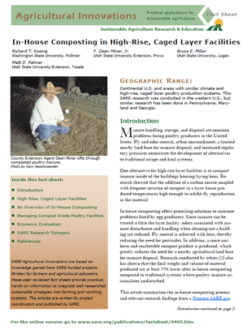Manure handling, storage, and disposal are common problems facing poultry producers in the United States. Fly and odor control, urban encroachment, a limited nearby land base for manure disposal, and increased regulatory pressures necessitate the development of alternatives to traditional scrape and haul systems.
One alternative for high-rise layer facilities is to compost manure inside of the buildings housing laying hens. Research showed that the addition of a carbon source coupled with frequent aeration of compost in a layer house produced temperatures high enough to inhibit fly reproduction in the material.
In-house composting offers promising solutions to common problems faced by egg producers. Since manure can be treated within the layer facility, odors associated with manure disturbance and handling when cleaning out a building are reduced. Fly control is achieved with heat, thereby reducing the need for pesticides. In addition, a more uniform and marketable compost product is produced, which greatly reduces the need for a nearby agricultural land base for manure disposal. Research conducted by others also has shown that the final weight and volume of material produced are at least 35% lower after in-house composting compared to traditional systems where poultry manure accumulates undisturbed.
Geographic Adaptability: Continental United States and areas with similar climate and high-rise, caged layer poultry production systems. This SARE research was conducted in the western United States, but similar research has been done in Pennsylvania, Maryland and Georgia.
Want more information? See the related SARE grant:
